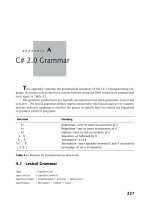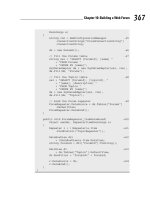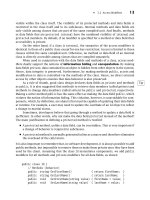Praise for C# 2.0: Practical Guide for Programmers 2005 phần 9 docx
Bạn đang xem bản rút gọn của tài liệu. Xem và tải ngay bản đầy đủ của tài liệu tại đây (428.07 KB, 28 trang )
186 Chapter 9: Resource Disposal, Input/Output, and Threads
■
by the .NET Framework. Responsibility for the disposal of unmanaged resources, therefore,
rests with the object itself and is encapsulated in a destructor as shown here:
public class ClassWithResources {
˜ClassWithResources() {
// Release resources
}
}
Although the destructor is typically concerned with the release of unmanaged resources,
it may also release (or flag) managed resources by setting object references to null. When
a destructor is explicitly defined, it is translated automatically into a virtual Finalize
method:
public class ClassWithResources {
virtual void Finalize() {
try {
// Release resources
}
finally {
base.Finalize(); // Base class chaining.
}
}
}
The finally clause chains back the disposal of resources to the parent object, its parent,
and so on until remaining resources are released by the root object.
Because the invocation of the destructor (or Finalize method) is triggered by the
garbage collector, its execution cannot be predicted. In order to ensure the release
of resources not managed by the garbage collector, the Close or Dispose method,
inherited from IDisposable, can be invoked explicitly. The IDisposable interface
given here provides a uniform way to explicitly release resources, both managed and
unmanaged.
interface IDisposable {
void Dispose();
}
Whenever the Dispose method is invoked explicitly, the GC.SuppressFinalize should also
be called to inform the garbage collector not to invoke the destructor (or Finalize method)
of the object. This avoids the duplicate disposal of managed resources.
To achieve this goal, two Dispose methods are generally required: one with no param-
eters as inherited from IDisposable and one with a boolean parameter. The following code
■
9.1 Resource Disposal 187
skeleton presents a typical strategy to dispose both managed and unmanaged resources
without duplicate effort.
public class ClassWithResources : IDisposable {
ClassWithResources() {
// Initialize resources
disposed = false;
}
˜ClassWithResources() { // Translated as Finalize()
Dispose(false);
}
public void Dispose() {
Dispose(true);
GC.SuppressFinalize(this);
}
protected virtual void Dispose(bool disposeManaged) {
if (!disposed) {
if (disposeManaged) {
// Code to dispose managed resources.
}
// Code to dispose unmanaged resources.
disposed = true;
}
}
private bool disposed;
}
If the Dispose method (without parameters) is not invoked, the destructor calls
Dispose(false) via the garbage collector. Only unmanaged resources in this case are
released since managed resources are automatically handled by the garbage collector.
If the Dispose method is invoked explicitly to release both managed and unmanaged
resources, it also advises the garbage collector not to invoke Finalize. Hence, managed
resources are not released twice. It is worth noting that the second Dispose method (with
the boolean parameter) is protected to allow overriding by the derived classes and to
avoid being called directly by clients.
The using statement shown here can also be used as a clean way to automatically
release all resources associated with any object that has implemented the Dispose method.
using ( anObjectWithResources ) {
// Use object and its resources.
}
188 Chapter 9: Resource Disposal, Input/Output, and Threads
■
In fact, the using statement is shorter but equivalent to the following try/finally block:
try {
// Use object and its resources.
}
finally {
if ( anObjectWithResources != null ) anObjectWithResources.Dispose();
}
The following example shows a common application of the using statement when opening
a text file:
using ( StreamReader sr = new StreamReader("file.txt") ) {
}
9.2 Input/Output
Thus far, our discussion on input/output has been limited to standard output streams
using the System.Console class. In this section, we examine how the .NET Frame-
work defines the functionality of input/output (I/O) via the System.IO namespace. This
namespace encapsulates classes that support read/write activities for binary, byte, and
character streams. The complete hierarchy of the System.IO namespace is given here:
System.Object
BinaryReader (Binary I/O Streams)
BinaryWriter
MarshallByRefObject
Stream (Byte I/O Streams)
BufferedStream
FileStream
MemoryStream
TextReader (Character I/O Streams)
TextWriter
StreamReader
StringReader
StreamWriter
StringWriter
Each type of stream is discussed in the sections that follow.
9.2.1 Using Binary Streams
The binary I/O streams, BinaryReader and BinaryWriter, are most efficient in terms of
space but at the price of being system-dependent in terms of data format. These streams
■
9.2 Input/Output 189
read/write simple data types such as byte, sbyte, char, ushort, short, and so on. In the
following example, an unsigned integer magicNumber and four unsigned short integers
stored in array data are first written to a binary file called file.bin and then read back
and output to a console.
1 using System.IO;
2
3 namespace BinaryStream {
4 class TestBinaryStream {
5 static void Main() {
6 uint magicNumber = 0xDECAF;
7
8 ushort[] data = { 0x0123, 0x4567, 0x89AB, 0xCDEF };
9
10 FileStream fs = new FileStream("file.bin", FileMode.Create);
11 BinaryWriter bw = new BinaryWriter(fs);
12
13 bw.Write(magicNumber);
14 foreach (ushort u in data)
15 bw.Write(u);
16
17 bw.Close();
18
19 fs = new FileStream("file.bin", FileMode.Open);
20 BinaryReader br = new BinaryReader(fs);
21
22 System.Console.WriteLine("{0:X8}", br.ReadUInt32() );
23 for(intn=0;n<data.Length; n++)
24 System.Console.WriteLine("{0:X4}", br.ReadUInt16() );
25
26 br.Close();
27 }
28 }
29 }
Once the array data is created and initialized on line 8, an instance of FileStream called fs
is instantiated on line 10 and logically bound to the physical file file.bin. The FileStream
class is actually a subclass of Stream, which is described in the next subsection. Next, an
instance of BinaryWriter called bw is created and associated with fs. It is used to write
the values from magicNumber and data to file.bin (lines 13–15). After bw is closed, the
program reads back the values from fs using an instance of BinaryReader called br, which
is created and associated with fs on line 20. The first value is read back as UInt32 (line 22),
and the remaining four are read back as UInt16 (lines 23–24). Each time, the integers are
output in their original hexadecimal format.
190 Chapter 9: Resource Disposal, Input/Output, and Threads
■
9.2.2 Using Byte Streams
The Stream abstract class given next defines all basic read/write methods in terms of
bytes. A stream is opened by creating an instance of a subclass of Stream chained with
its protected default constructor. The stream is then closed by explicitly invoking the
Close method. This method flushes and releases any associated resources, such as net-
work connections or file handlers, before closing the stream. The Flush method can also
be invoked explicitly in order to write all memory buffers to the stream.
abstract class Stream : MarshalByRefObject, IDisposable {
Stream(); // Opens the stream.
virtual void Close(); // Flushes and releases any resources.
abstract void Flush();
abstract int Read (byte[] buffer, int offset, int count);
abstract void Write(byte[] buffer, int offset, int count);
virtual int ReadByte();
virtual void WriteByte(byte value);
abstract bool CanRead {get;} // True if the current stream
// supports reading.
abstract bool CanSeek {get;} // True if the current stream
// supports seeking.
abstract bool CanWrite {get;} // True if the current stream
// supports writing.
abstract long Length {get;} // The length of the stream in bytes.
abstract long Position {get; set;}// The position within the current
// stream.
}
The Stream class supports both synchronous and asynchronous reads/writes on the same
opened stream. Synchronous I/O means that the main (thread) application is blocked and
must wait until the I/O operation is complete in order to return from the read/write
method. On the other hand, with asynchronous I/O, the main application can call the
sequence BeginRead/EndRead or BeginWrite/EndWrite in such a way that it can keep up
with its own work (timeslice).
The Stream class inherits from one class and one interface. The MarshalByRefObject
class provides the ability for stream objects to be marshaled by reference. Hence, when
an object is transmitted to another application domain (AppDomain), a proxy of that object
with the same public interface is automatically created on the remote machine and serves
as an intermediary between it and the original object.
The Stream abstract class is the base class for three byte I/O streams:
BufferedStream, FileStream, and MemoryStream. The BufferedStream class offers buffered
I/O and, hence, reduces the number of disk accesses. The FileStream class binds I/O
■
9.2 Input/Output 191
streams with a specific file. And the MemoryStream class emulates I/O streams from disk or
remote connection by allowing direct read/write access in memory. The following example
illustrates the use of both BufferedStream and FileStream to read a file as a sequence of
bytes until the end of stream is reached:
using System.IO;
namespace ByteStream {
class TestByteStream {
static void Main() {
FileStream fs = new FileStream("ByteStream.cs", FileMode.Open);
BufferedStream bs = new BufferedStream(fs);
int c;
while ( (c = bs.ReadByte()) != -1 )
System.Console.Write((char)c);
bs.Close();
}
}
}
This well-known programming idiom reads a byte within the while loop where it is
assigned to an integer c and compared to end-of-stream (−1). Although bytes are read,
it is important to store each character into a meta-character c that is larger than 16-bits
(Unicode), in our case, an int of 32-bits. If not, the possibility of reading non-printable
characters such as 0xFFFF (-1 on a 16-bit signed) from a binary or text file will have the
effect of exiting the loop before reaching the end-of-stream.
9.2.3 Using Character Streams
Analogous to the Stream abstract class, the character I/O streams, TextReader and
TextWriter, are abstract base classes for reading and writing an array of characters or
a string. The concrete classes, StreamReader and StreamWriter, implement TextReader
and TextWriter, respectively, in order to read/write characters from/to a byte stream
in a particular encoding. Similarly, the concrete classes, StringReader and StringWriter,
implement TextReader and TextWriter in order to read/write strings stored in an underly-
ing StringBuilder. The following program copies the text file src to the text file dst using
instances of StreamReader and StreamWriter to read from and write to their respective
files. In the first version, the copying is done character by character.
1 using System.IO;
2
3 namespace CharacterStream {
192 Chapter 9: Resource Disposal, Input/Output, and Threads
■
4 class Copy {
5 static void Main(string[] args) {
6 if (args.Length != 2) {
7 System.Console.WriteLine("Usage: cp <src> <dst>");
8 return;
9}
10 FileStream src = new FileStream(args[0], FileMode.Open);
11 FileStream dst = new FileStream(args[1], FileMode.Create);
12 StreamReader srcReader = new StreamReader(src);
13 StreamWriter dstWriter = new StreamWriter(dst);
14
15 for (int c; (c = srcReader.Read()) != -1; )
16 dstWriter.Write((char)c);
17
18 srcReader.Close();
19 dstWriter.Close();
20 }
21 }
22 }
When lines 15 and 16 are replaced with those below, copying from the source to destination
files is done line by line.
for (string s; (s = srcReader.ReadLine()) != null; )
dstWriter.WriteLine(s);
9.2.4 Reading XML Documents from Streams
As demonstrated in the previous three sections, streams are powerful and flexible
pipelines. Although a discussion of XML is well beyond the scope of this book, it is
interesting, nonetheless, to briefly illustrate how XML files can be read from different
Stream-based sources: files, strings, and so on.
The class XmlTextReader is one class that provides support, such as node-based nav-
igation for reading XML files. In the first example, an instance of FileStream pipes data
from the file file.xml on disk to an instance of XmlTextReader:
new System.Xml.XmlTextReader( new FileStream("file.xml", FileMode.Open) )
In this second example, an instance of StringReader pipes data from the string xml in
memory to an instance of XmlTextReader:
new System.Xml.XmlTextReader( new StringReader( xml ) )
■
9.3 Threads 193
9.3 Threads
Many years ago, operating systems introduced the notion of a process in order to execute
multiple programs on the same processor. This gave the user the impression that programs
were executing “simultaneously,” albeit on a single central processing unit. Each program,
represented as a process, was isolated in an individual workspace for protection. Because
of these protections, using processes for client/server applications gave rise to two perfor-
mance issues. First, the context switch to reschedule a process (save the running process
and restore the next ready one) was quite slow. And second, I/O activities could force
context switches that were simply unacceptable, for example, blocking a process for I/O
and preventing the completion of its execution time slice.
Today, all commercial operating systems offer a more efficient solution known as the
lightweight process or thread. The traditional process now behaves like a small operating
system where a thread scheduler selects and appoints threads (of execution) within its
own workspace. Although a thread may be blocked for I/O, several other threads within a
process can be rescheduled in order to complete the time slice. The average throughput
of an application then becomes more efficient. Multi-threaded applications are very useful
to service multiple clients and perform multiple simultaneous access to I/O, databases,
networks, and so on. In this way, overall performance is improved, but sharing resources
still requires mechanisms for synchronization and mutual exclusion. In this section, we
present the System.Threading namespace containing all classes needed to achieve multi-
threaded or concurrent programming in C# on the .NET Framework.
9.3.1 Examining the Thread Class and Thread States
Each thread is an instance of the System.Threading.Thread class and can be in one of
several states defined in the enumeration called ThreadState as shown in Figure 9.1. When
created, a thread goes into the Unstarted or ready state. By invoking the Start method, a
thread is placed into a ready queue where it is eligible for selection as the next running
thread. When a thread begins its execution, it enters into the Running state. When a thread
has finished running and ends normally, it moves into the StopRequested state and is later
transferred to the Stopped or terminated state when garbage collection has been safely
performed. A running thread enters the WaitSleepJoin state if one of three invocations is
done: Wait, Sleep,orJoin. In each case, the thread resumes execution when the blocking
is done. A running thread can also be suspended via a call to the Suspend method. An
invocation of Resume places the thread back into the Running state. Finally, a thread may
enter into the AbortRequested state and is later transferred to the Aborted or terminated
state when garbage collection has been safely performed.
All threads are created with the same priority by the scheduler. If priorities are not
modified, all user threads are run in a round-robin fashion. It is possible, however, to
change the priority of a thread, but care should be exercised. A higher-priority thread
may never relinquish control, and a lower-priority thread may never execute. In C#, there
are five possible priorities: Lowest, BelowNormal, Normal, AboveNormal, and Highest. The
default priority is Normal.
194 Chapter 9: Resource Disposal, Input/Output, and Threads
■
Stopped
ending
normally
Start()
Sleep()
or
Join()
or
Wait()
waiting done
Abort()
Suspend()
Resume()
StopRequested
Unstarted
Running
Suspended
SuspendRequested
WaitSleepJoin Aborted
AbortRequested
Figure 9.1: Thread states and transitions.
9.3.2 Creating and Starting Threads
A thread executes a code section that is encapsulated within a method. It is good practiceTip
to define such a method as private, to name it as void Run() { }, and to include an
infinite loop that periodically or aperiodically sends/receives information to/from other
threads. This method is the execution entry point specified as a parameterless delegate
called ThreadStart:
delegate void ThreadStart();
In the following example, the constructor of the class MyThread creates a thread on line 6
using the previous delegate as a parameter, initializes number to the given parameter on
line 7, and places the thread in the ready queue on line 8. Two threads, t1 and t2, are
instantiated on lines 21 and 22 with 1 and 2 as parameters.
1 using System.Threading;
2
3 namespace BasicDotNet {
4 public class MyThread {
5 public MyThread(int number) {
6 t = new Thread(new ThreadStart(this.Run));
7 this.number = number;
8 t.Start();
9}
10 private void Run() {
11 while (true)
12 System.Console.Write("{0}", number);
13 }
■
9.3 Threads 195
14 private Thread t;
15 private int number;
16 }
17
18 public class MainThread {
19 public static void Main() {
20 System.Console.WriteLine("Main Started.");
21 MyThread t1 = new MyThread(1);
22 MyThread t2 = new MyThread(2);
23 System.Console.WriteLine("Main: done.");
24 }
25 }
26 }
Each thread prints its own number until its timeslice expires. Upon expiration, the sched-
uler picks the next ready thread for execution. Notice that the MainThread ends normally
after starting both threads t1 and t2 as shown in the following output:
Main Started.
Main: done.
1111111111111111111111111111111111111111111111111111111111111111111111111111
1111111111111111111111111111111222222222222222222222222222222222222222222222
2222222222222222222222222222222222222222222222222222222222222222222222222222
2222222222222222222222222222222111111111111111111111111111111111111111111111
1111111111111111111111111111111111111111111111111111111111111111111111111111
1111111111111111111111111111111222222222222222222222222222222222222222222222
222222222222222222222222222222222222222222222222222222222222222
On line 6, a delegate inference may also be used to assign the method name this.Run to
the Thread constructor as follows:
t = new Thread(this.Run);
In this case, the explicit creation of a ThreadStart delegate is avoided.
9.3.3 Rescheduling and Pausing Threads
The Thread.Sleep method pauses the current thread for a specified time in milliseconds.
If the time is zero (0), then the current thread simply relinquishes control to the scheduler
and is immediately placed in the ready queue, allowing other waiting threads to run. For
example, if the following Run method is used within the MyThread class, the values 1 and
2 are alternatively output as each thread is immediately paused after writing its number:
private void Run() {
while (true) {
Thread.Sleep(0);
196 Chapter 9: Resource Disposal, Input/Output, and Threads
■
System.Console.Write("{0}", number);
}
}
Output:
Main Started.
Main: done.
1212121212121212121
In another example, each thread is paused for a length of time proportional to its own
thread number, one and two seconds, respectively. Hence, the thread with number equal
to 1 is able to print on average twice the number of values as the thread with number equal
to 2.
private void Run() {
while (true) {
Thread.Sleep(number * 1000);
System.Console.Write("{0}", number);
}
}
Output:
Main Started.
Main: done.
1211211211211211211
9.3.4 Suspending, Resuming, and Stopping Threads
In the following example, the Main thread creates two threads, t1 and t2, on lines 35
and 36. Note that both threads are started within the constructor of MyThread. When
not suspended or stopped, the threads run for a timeslice of 10 seconds while the Main
thread sleeps. During the first timeslice on line 38, both threads print their respec-
tive numbers. When the Main thread awakens, it immediately suspends t1 (line 39) and
puts itself to sleep once again for ten seconds (line 40). In the meantime, the sec-
ond thread t2 continues to print out its number every two seconds. When the Main
thread awakens for the second time, thread t1 is resumed and both threads execute
for a timeslice of another ten seconds. Finally, thread t1 is stopped on line 43 and
ten seconds later, thread t2 is stopped on line 45 before the Main thread ends itself
normally.
1 using System.Threading;
2
3 namespace BasicDotNet {
■
9.3 Threads 197
4 public class MyThread {
5 public MyThread(int number) {
6 t = new Thread(Run);
7 this.number = number;
8 t.Start();
9}
10 private void Run() {
11 while (true) {
12 Thread.Sleep(number * 1000);
13 System.Console.Write("{0}", number);
14 }
15 }
16 public void Suspend() {
17 System.Console.WriteLine("\nThread {0} suspended", number);
18 t.Suspend();
19 }
20 public void Resume() {
21 System.Console.WriteLine("\nThread {0} resumed", number);
22 t.Resume();
23 }
24 public void Stop() {
25 System.Console.WriteLine("\nThread {0} stopped", number);
26 t.Abort();
27 }
28 private Thread t;
29 private int number;
30 }
31
32 public class MainThread {
33 public static void Main() {
34 System.Console.WriteLine("Main Started.");
35 MyThread t1 = new MyThread(1);
36 MyThread t2 = new MyThread(2);
37
38 Thread.Sleep(10 * 1000);
39 t1.Suspend();
40 Thread.Sleep(10 * 1000);
41 t1.Resume();
42 Thread.Sleep(10 * 1000);
43 t1.Stop();
44 Thread.Sleep(10 * 1000);
45 t2.Stop();
46
47 System.Console.WriteLine("Main: done.");
198 Chapter 9: Resource Disposal, Input/Output, and Threads
■
48 }
49 }
50 }
Output:
Main Started.
1211211211211
Thread 1 suspended
22222
Thread 1 resumed
121121121121121
Thread 1 stopped
22222
Thread 2 stopped
Main: done.
It is worth noting that when a thread is aborted, the runtime system throws a
ThreadAbortException that cannot be caught. However, it does execute all finally blocks
before the thread terminates. Also, an exception is thrown if a Suspend invocation is made
on a thread that is already suspended or if a Resume invocation is made on a thread that
is not suspended. Because code that uses the Suspend and Resume methods is deadlock-
prone, both methods have been deprecated (made obsolete) in the latest version of the
.NET Framework.
9.3.5 Joining and Determining Alive Threads
A thread is alive once it is moved from the Unstarted state and has yet to be aborted or
terminated normally. If a thread is alive, then the method IsAlive returns true. Other-
wise, it returns false. A thread may also block itself until another thread has terminated.
Hence, the thread that invokes the method <specifiedThread>.Join waits until the spec-
ified thread ends its execution. The overloaded Join method may also be invoked with a
TimeSpan parameter that sets the maximum time delay for the specified thread to termi-
nate. Finally, if the specified thread has not been started, then a ThreadStateException is
thrown.
In the following example, the Main thread spawns two other threads, t1 and t2,on
lines 11 and 12. In addition, the current thread (in this case Main) is assigned to me on
line 13 using the read-only property CurrentThread. On lines 14 to 19, the status of the
three threads, either alive or unstarted, is output based on the return value of IsAlive.
The main thread then starts t1 and t2 on lines 20 and 21, making them alive to print their
respective numbers 1 and 2. Thereafter, the main thread waits on t1 and t2 by invoking
the Join method with the appropriate thread on lines 27 and 32, respectively. To verify
that threads t1 and t2 are indeed terminated, an output message is generated on lines 29
and 34.
■
9.3 Threads 199
1 using System.Threading;
2
3 namespace BasicDotNet {
4 public class MainThread {
5 private static void One() { System.Console.WriteLine("1");
6 Thread.Sleep(1000); }
7 private static void Two() { System.Console.WriteLine("2");
8 Thread.Sleep(2000); }
9
10 public static void Main() {
11 Thread t1 = new Thread(One);
12 Thread t2 = new Thread(Two);
13 Thread me = Thread.CurrentThread;
14 System.Console.WriteLine("Main [{0}].", me.IsAlive ? "Alive" :
15 "Unstarted");
16 System.Console.WriteLine("One [{0}].", t1.IsAlive ? "Alive" :
17 "Unstarted");
18 System.Console.WriteLine("Two [{0}].", t2.IsAlive ? "Alive" :
19 "Unstarted");
20 t1.Start();
21 t2.Start();
22 System.Console.WriteLine("One [{0}].", t1.IsAlive ? "Alive" :
23 "Unstarted");
24 System.Console.WriteLine("Two [{0}].", t2.IsAlive ? "Alive" :
25 "Unstarted");
26
27 t1.Join();
28 System.Console.WriteLine("One joined.");
29 System.Console.WriteLine("One [{0}].", t1.IsAlive ? "Alive" :
30 "Ended");
31
32 t2.Join();
33 System.Console.WriteLine("Two joined.");
34 System.Console.WriteLine("Two [{0}].", t2.IsAlive ? "Alive" :
35 "Ended");
36 System.Console.WriteLine("Main ending ");
37 }
38 }
39 }
Output:
Main [Alive].
One [Unstarted].
Two [Unstarted].
200 Chapter 9: Resource Disposal, Input/Output, and Threads
■
One [Alive].
Two [Alive].
1
2
One joined.
One [Ended].
Two joined.
Two [Ended].
Main ending
9.3.6 Synchronizing Threads
In order to allow multiple threads to access a shared resource or critical section in a safe
and predictable way, some synchronization mechanism is required. Otherwise, access is
chaotic. Such synchronization is achieved by serializing threads and thereby ensuring that
only one thread at a time is able to execute within a critical section. In C#, the mechanism
to ensure mutual exclusion to a critical section is based on the notion of locks.
Using the lock Statement
A lock statement in C# is associated with any class or object, including this. A thread that
wishes to enter a critical section is first placed in a ready queue associated with the lock
(not to be confused with the ready queue of the threading system). Once a lock becomes
available, a thread is chosen from the ready queue to acquire the lock and enter the crit-
ical section that it wishes to execute. Upon completion of the critical section, the thread
releases the lock, enabling another thread from the ready queue to obtain the lock and
enter a critical section associated with the lock. Until the critical section is exited and the
lock is released, no other thread may access the critical section of the object or class. The
syntax of the lock statement is shown here. In this example, a lock is associated with an
object called obj.
lock ( obj ) { // Acquire (an object) lock and enter critical section.
// Execute critical section.
} // Exit critical section and release the (object) lock.
Any thread that is currently executing the critical section prevents other threads from
entering any code section protected by lock(obj) for the same object obj. In another
example, a lock is associated with a class called C.
lock ( typeof(C) ) { // Refer to the meta-class of C and lock its class.
// Execute critical section.
}
Here, any thread that is currently executing the critical section prevents other threads
from entering any code section protected by lock(typeof(C)) for the same class C. The
following example illustrates the use of the System.Type object of the SharedFunctions
■
9.3 Threads 201
class as the lock for the Add and Remove static methods here:
class SharedFunctions {
public static void Add(object x) {
lock ( typeof(SharedFunctions) ) {
// Critical section
}
}
public static void Remove(object x) {
lock ( typeof(SharedFunctions) ) {
// Critical section
}
}
}
It is good programming practice to only lock private or internal objects and classes.
Tip
Because external threads have no access to private or internal lock objects or classes,
the possibility of external threads creating deadlocks is precluded.
Once inside a critical section, a thread may block itself. In this case, the thread is
placed in a waiting queue and releases the lock. The waiting queue, like the ready queue,
is associated with the lock. The thread remains in the waiting queue until another thread,
currently executing in the critical section, signals to one or more threads in the waiting
queue to move back to the ready queue. Once a thread is moved back to the ready queue, it
is eligible to re-acquire the lock on the critical section. However, once acquired, the execu-
tion of the thread within the critical section recommences at the point where it originally
blocked itself.
Using the Monitor Class
The implementation of the lock statement in C# is based on the synchronization primitives
defined here in the Monitor class of the .NET Framework.
public sealed class Monitor {
public static void Enter(object);
public static void Exit(object);
public static void Pulse(object);
public static void PulseAll(object);
public static bool TryEnter(object);
public static bool TryEnter(object, int);
public static bool TryEnter(object, TimeSpan);
public static bool Wait(object);
}
202 Chapter 9: Resource Disposal, Input/Output, and Threads
■
All methods in the Monitor class are static. Also, because the class Monitor is sealed,
no other class is able to derive from it. The methods Enter and Exit acquire and release
an exclusive lock on a specific object or class. These methods are used for surrounding
a critical section in order to achieve thread synchronization. A thread that invokes Enter
remains in the ready queue (waits) if another thread currently holds the lock to the critical
section it wishes to enter. Otherwise, it is able to obtain the lock and continue execution
within the critical section. An invocation of Exit, on the other hand, releases the lock,
enabling another thread (if any) from the ready queue to acquire the lock and enter a
critical section associated with the lock. The lock statement, therefore, is equivalent to
the following statements:
Monitor.Enter( obj );
try {
// Critical section
} finally {
Monitor.Exit( obj );
}
If a thread wishes to “peek” at a critical section and avoid being blocked, it can invoke
the method TryEnter that returns false if the critical section is busy. The two additional
TryEnter methods wait for a maximum of int milliseconds or a specific TimeSpan to acquire
the lock on the given object.
The Wait method invoked by a thread within a critical section releases the lock of the
critical section, blocks the calling thread and places it on the waiting queue, and enables
another thread to enter a critical section associated with the lock. Conversely, when a
thread invokes the Pulse or PulseAll method within a critical section, one or all threads
who were previously blocked using the Wait method on the same object are moved from
the waiting queue back to the ready queue. It is important to emphasize once again that
once a thread re-acquires a lock and re-enters a critical section, its execution recommences
at the point where it originally blocked itself.
As an example of synchronization, consider a multiplexer that combines two serial
data streams into a single parallel output stream as shown in Figure 9.2. If characters
arrive at either serial input port, maximum throughput is achieved when the application
Serial port Thread
Serial port Thread
ThreadBuffer Parallel port
Figure 9.2: Thread synchronization in accessing a buffer.
■
9.3 Threads 203
is able to process input from both serial ports simultaneously and to provide output to
the parallel port. A multi-threaded application of the multiplexer uses three threads and
is implemented as follows.
1 using System;
2 using System.Threading;
3
4 class Buffer {
5 private readonly int Max;
6
7 public Buffer(int max) {
8 Max = max;
9 head = tail = count = 0;
10 buffer = new char[Max];
11 full = false;
12 empty = true;
13 }
14 public void put(char c) {
15 lock (this) { // Critical section access to buffer using lock.
16 while (full) Monitor.Wait(this); // Blocks if buffer full.
17
18 buffer[tail] = c;
19 if (++count == Max) full = true;
20 empty = false;
21 tail = (tail + 1) % Max;
22 Monitor.Pulse(this); // Notifies the parallel port.
23 }
24 }
25 public char get() {
26 char c;
27 // lock (this) {
28 Monitor.Enter(this); // Critical section access to buffer using Monitor.
29 try {
30 while (empty) Monitor.Wait(this); // Blocks if buffer empty.
31
32 c = buffer[head];
33 if ( count == 0) empty = true;
34 full = false;
35 head = (head + 1) % Max;
36 Monitor.PulseAll(this); // Notifies all serial ports.
37 } finally {
38 Monitor.Exit(this);
39 }
204 Chapter 9: Resource Disposal, Input/Output, and Threads
■
40 // }
41 return c;
42 }
43 private char[] buffer;
44 private bool full, empty;
45 private int head, tail, count;
46 }
47
48 class SerialPortThread {
49 public SerialPortThread(Buffer buffer, int num) {
50 this.buffer = buffer;
51 this.num = num;
52 }
53 private static char inputFromSerial() {
54 Thread.Sleep(500); // Waits 0.5 sec (to emulate communication latency).
55 return c++;
56 }
57 public void run() {
58 while (true) {
59 char c = inputFromSerial();
60 Console.WriteLine("sp{0} {1}", num, c);
61 buffer.put(c);
62 }
63 }
64 private static char c = ’a’; // Shared by all serial ports.
65 private int num;
66 private Buffer buffer;
67 }
68
69 class ParallelPortThread {
70 public ParallelPortThread(Buffer buffer) {
71 this.buffer = buffer;
72 }
73 public void run() {
74 while (true) {
75 char c = buffer.get();
76 Console.WriteLine(" pp {0}", c);
77 Thread.Sleep(100); // Waits 0.1 sec (to emulate printing latency).
78 }
79 }
80 private Buffer buffer;
81 }
82
83 class Multiplexer {
■
9.3 Threads 205
84 public static void Main() { // Main thread entry.
85 Buffer buf = new Buffer(4);
86 SerialPortThread sp1 = new SerialPortThread(buf, 1);
87 SerialPortThread sp2 = new SerialPortThread(buf, 2);
88 ParallelPortThread pp = new ParallelPortThread(buf);
89
90 // Creates all threads passing on their run entry points.
91 Thread s1 = new Thread(new ThreadStart(sp1.run));
92 Thread s2 = new Thread(new ThreadStart(sp2.run));
93 Thread p = new Thread(new ThreadStart(pp.run));
94
95 Console.WriteLine(" in out");
96
97 s1.Start(); // Starts first serial port.
98 s2.Start(); // Starts second serial port.
99 p.Start(); // Starts parallel port.
100 }
101 }
On line 85, a buffer buf of size four is instantiated. Two serial ports, sp1 and sp2, and
one parallel port, pp, are instantiated on lines 86–88 with a reference to the same buffer
buf. Three threads, created on lines 91–93 with their corresponding run entry points,
begin execution on lines 97–99. Although the main thread completes execution, the three
threads continue to run “forever.”
In the SerialPortThread class, the run method entry point contains an infinite loop
(lines 58–62) that inputs a character from a serial port and places it in the shared buffer.
On the other hand, in the ParallelPortThread class, the run method entry also contains
an infinite loop (lines 74–78) that reads from the shared buffer and prints the character
that is read.
To synchronize access to the shared buffer, the methods put and get must contain
critical sections. When the parallel port thread attempts to get a character, verification
on line 30 checks if the buffer is empty. If so, the thread is blocked until one of the
two serial threads puts a character in the shared buffer. Conversely, when a serial port
thread attempts to put a character into the shared buffer, verification on line 16 checks
if the buffer is full. If so, the thread is blocked until the parallel thread gets a charac-
ter from the shared buffer. A serial port notifies the parallel port on line 22 using the
Pulse method that the buffer is no longer empty, whereas the parallel port on line 36
uses the PulseAll method to inform all serial ports that the buffer is no longer full. It
is worth noting that the lock mechanism for the put method uses the lock statement,
and that the lock mechanism for the get method defines the equivalent lock using the
methods of Monitor. The following sample output illustrates that no characters are lost
and that all threads are well synchronized without concern for their relative speed or
starting order.
206 Chapter 9: Resource Disposal, Input/Output, and Threads
■
in out
sp1 a
pp a
sp2 b
pp b
sp1 c
sp2 d
pp c
pp d
sp1 e
pp e
sp2 f
sp1 g
pp f
pp g
sp2 h
pp h
sp1 i
pp i
In the .NET Framework, most collection classes are not thread safe by default. They
can become thread safe by implementing a synchronized method or by using the lock
statement (or Monitor methods) via the SyncRoot property.
As a final note, the .NET Framework System.Threading namespace provides a class
called ThreadPool that facilitates the handling of multiple threads often used in socket
connections, wait operations from ports or I/O, and so on. This class allows one to create,
start, and manage many individual concurrent activities without having to set properties
for each thread. Another useful class in this namespace is the Timer class that periodically
executes a method at specified intervals on a separate thread. A thread timer may be used
to signal back-ups for files and databases.
Exercises
Exercise 9-1. The previous object-oriented version of the Unix word count wc utility
supports standard input only. Improve this utility by allowing a developer to count from
optional specified files as shown here:
WcCommandLine = "wc" Options? Files? .
Exercise 9-2. Write a class TestContact that contains a method LoadFile that loads and
creates contact objects from a text file using a try/catch/finally block. The text file is
■
Exercises 207
formatted as follows:
de Champlain;Michel;
Patrick;Brian;
Hint: Reuse the class StringTokenizer suggested in Exercise 4-2.
Exercise 9-3. The singleton implementation on pages 33–34 is not thread safe. Write one
that is thread safe.
Exercise 9-4. In order to complete a TUI to enter organizations, use the following
abstract class as a foundation to implement an application called eOrg.exe:
namespace eCard.Presentation.TUI {
public abstract class AbstractShell {
public AbstractShell(string version, string copyright) {
this.version = version;
this.copyright = copyright;
// Display the application’s banner
About();
}
protected virtual string Version { get { return version; } }
protected virtual string Copyright { get { return copyright; } }
protected virtual void About() {
Console.WriteLine("\n"+Version+"\nCopyright (c)"+Copyright+"\n");
}
protected abstract void New();
protected abstract void Edit();
protected abstract void Delete();
public abstract void Run(string[] args);
private string version;
private string copyright;
}
}
This application loads organizations from an orgs.org file and allows a user to enter, edit,
and remove them, as shown in the following sample execution:
eOrg v1.0
Loading organizations
0 organizations loaded.
N)ew E)dit D)elete L)ist S)ave As Q)uit and save Enter your choice: N
208 Chapter 9: Resource Disposal, Input/Output, and Threads
■
Name: DeepObjectKnowledge Inc.
DomainName: DeepObjectKnowledge.com
1) First.Last 2) Last.First 3) F.Last 4) Last.F 5) F+Last
6) Last+F 7) F.L 8) L.F 9) F+L 10) L+F
11) First+Last 12) Last+First 13) F_L 14) L_F 15) F_Last
16) Last_F 17) First_Last 18) Last_First 19) Other.
EmailFormat: 19
N)ew E)dit D)elete L)ist S)ave As Q)uit and save Enter your choice: L
No Domain Name EmailFormat
1 DeepObjectKnowledge.com DeepObjectKnowledge Inc. Other.
N)ew E)dit D)elete L)ist S)ave As Q)uit and save Enter your choice: N
Name: University of Trent
Domain Name: trentu.ca
1) First.Last 2) Last.First 3) F.Last 4) Last.F 5) F+Last
6) Last+F 7) F.L 8) L.F 9) F+L 10) L+F
11) First+Last 12) Last+First 13) F_L 14) L_F 15) F_Last
16) Last_F 17) First_Last 18) Last_First 19) Other.
EmailFormat: 5
N)ew E)dit D)elete L)ist S)ave As Q)uit and save Enter your choice: E
No: 2
Name: University of Trent
DomainName: trentu.ca
EmailFormat: F+Last
N)ame D)omainName E)mailFormat O)K Enter your choice: N
Name: Trent University
Name: Trent University
DomainName: trentu.ca
EmailFormat: F+Last
N)ame D)omainName E)mailFormat O)K Enter your choice: O
N)ew E)dit D)elete L)ist S)ave As Q)uit and save Enter your choice: L
■
Exercises 209
No Domain Name EmailFormat
1 DeepObjectKnowledge.com DeepObjectKnowledge Inc. Other.
2 trentu.ca Trent University F+Last
N)ew E)dit D)elete L)ist S)ave As Q)uit and save Enter your choice: Q
Saving 2 organizations in ’orgs.org’
Hint: Reuse the classes StringTokenizer (from Exercise 4-2), EmailFormat (from Exercise
6-2), and Input (from Exercise 6-4). Backups can be done using the “Save As " option.
chapter 10
Reflection and Attributes
Applications in older programming languages provided little data about themselves
other than lines of code, required memory, and other basic tidbits of information. But as
software applications become more complex and rely more heavily on growing libraries of
reusable code, there is an increasing burden on software management. The extraction of
information about an application is called reflection and makes extensive use of metadata
that is gathered from the compilation process.
Attributes are one type of metadata and are used to annotate code. These attributes
may be pre- or user-defined and help guide the developer toward those modules or classes
that satisfy certain requirements. Reflection, in this sense, is analogous to searching
on keywords except that attributes are derived classes and are replete with their own
methods. Certain attributes, such as Obsolete, inform developers when code is replaced
and must be updated. It is an issue of vital importance when applications rely on different
versions of code in order to compile and execute correctly. In this chapter, we introduce
the process of reflection and the creation and use of metadata using attributes.
10.1 Reflection
Reflection is the ability to look into and access information or metadata about an
application itself. Applications such as debuggers, builders, and integrated development
environments that extract and rely on this information are called meta-applications. For
example, the IntelliSense feature of Visual Studio .NET presents to the user a list of available
public members whenever a dot (.) is typed after a class name or an object reference.
In the .NET Framework, reflection or meta-programming is supported by the
System.Reflection namespace. In the sections that follow, we examine the reflection
211









